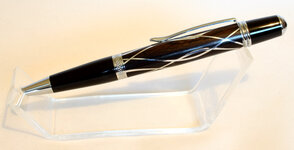jkeithrussell
Member
- Joined
- Oct 20, 2008
- Messages
- 1,277
I took a first stab at making a segmented pen last night. It was a simple design based on one of the tutorials in the library, only I added some thin strips of aluminum between the sections. Basically took a Holly blank and a Purpleheart blank, stacked them, cut curved shapes on each end, swapped the pieces, and sandwiched a thin slice of aluminum.
I got in a hurry and it didn't work out right. The main problem I had was that my tools kept catching on the aluminum which caused the aluminum to bend back a little bit in several places. I suspect that the cause is simply not giving the segmented blank enough time to set up. The aluminum sheet that I used was .008 thickness. Is that too thick? I picked it up at Ace. It feels considerably thicker than a soda can, but it doesn't look thicker than others that are posted here.
Thoughts?
I got in a hurry and it didn't work out right. The main problem I had was that my tools kept catching on the aluminum which caused the aluminum to bend back a little bit in several places. I suspect that the cause is simply not giving the segmented blank enough time to set up. The aluminum sheet that I used was .008 thickness. Is that too thick? I picked it up at Ace. It feels considerably thicker than a soda can, but it doesn't look thicker than others that are posted here.
Thoughts?

